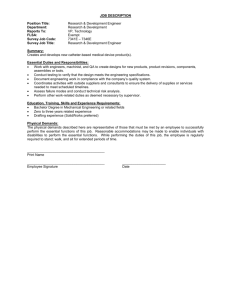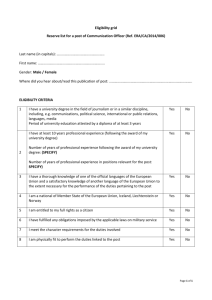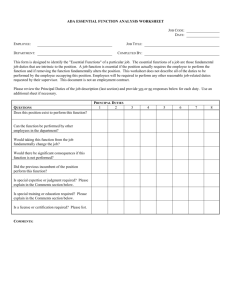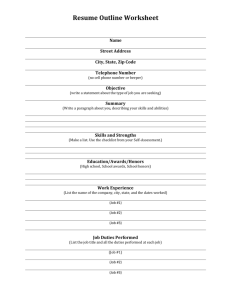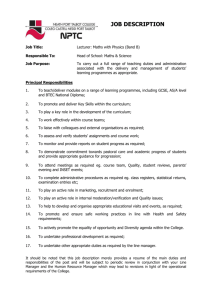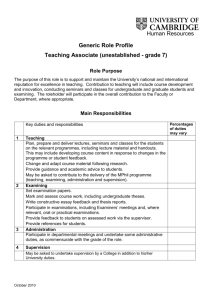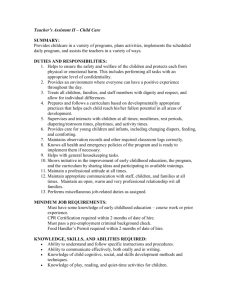A Step by Step Guide to Writing a Statement of Duties (SoD) 4 8 9
advertisement
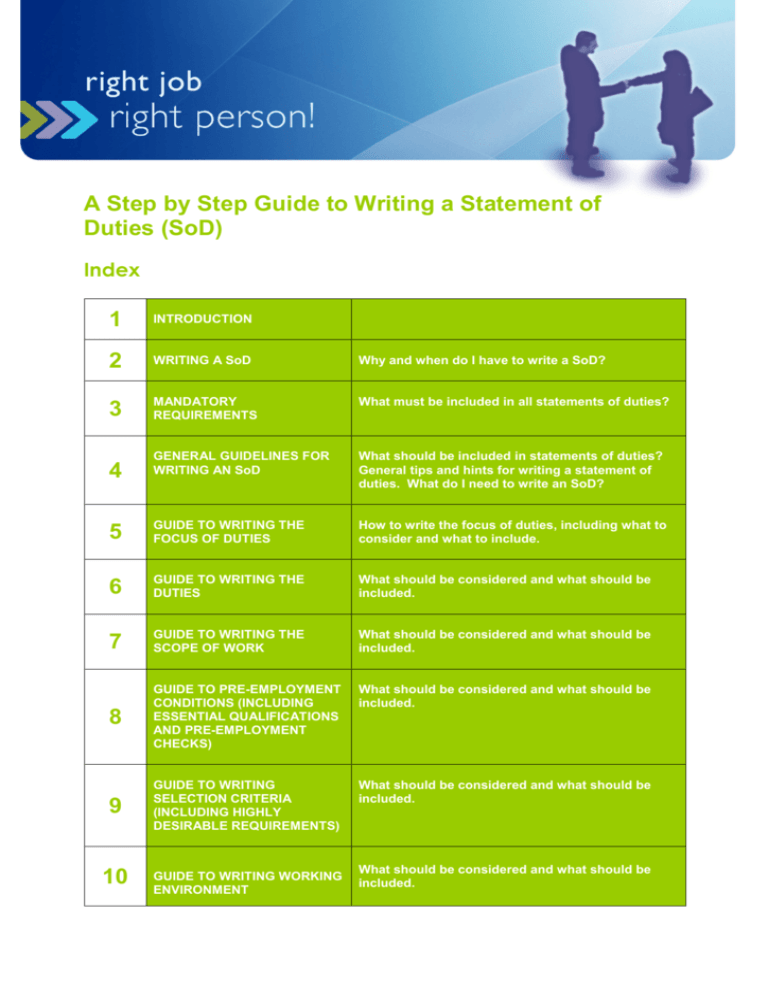
A Step by Step Guide to Writing a Statement of Duties (SoD) Index 1 INTRODUCTION 2 WRITING A SoD Why and when do I have to write a SoD? 3 MANDATORY REQUIREMENTS What must be included in all statements of duties? GENERAL GUIDELINES FOR WRITING AN SoD What should be included in statements of duties? General tips and hints for writing a statement of duties. What do I need to write an SoD? 5 GUIDE TO WRITING THE FOCUS OF DUTIES How to write the focus of duties, including what to consider and what to include. 6 GUIDE TO WRITING THE DUTIES What should be considered and what should be included. 7 GUIDE TO WRITING THE SCOPE OF WORK What should be considered and what should be included. 8 GUIDE TO PRE-EMPLOYMENT CONDITIONS (INCLUDING ESSENTIAL QUALIFICATIONS AND PRE-EMPLOYMENT CHECKS) What should be considered and what should be included. 9 GUIDE TO WRITING SELECTION CRITERIA (INCLUDING HIGHLY DESIRABLE REQUIREMENTS) What should be considered and what should be included. 4 10 GUIDE TO WRITING WORKING ENVIRONMENT What should be considered and what should be included. 11 RESPONSIBILITIES Group Delegates, Recruitment Services, HR relationship management teams, Director Human Resources. 12 RELEVANT DOCUMENTATION Links, templates, legislation and other resources. APPENDICES 1 A) B) A checklist for your convenience. Exercise to assist in writing duties and scope of work. INTRODUCTION This guide has been developed to assist managers with the writing of statements of duties. This guide should be used in conjunction with the Right Job, Right Person! Recruitment and Selection Framework, in particular Stage 1 – Define. Key Stakeholders 2 Group delegate Recruitment Services HR relationship management teams Director Human Resources REASONS FOR WRITING AN SoD Why do I Need to Write a Statement of Duties? Statements of duties are used for a number of different purposes and as such it is important to have a clear and concise description of the role’s focus, the duties, the responsibilities, and the skills and knowledge required to undertake the role. Statements of duties are used in: Recruitment processes – for designing the advertisement and using the selection criteria to determine the ability of each applicant to undertake the role. Role clarification – employees undertaking the role or potential applicants to the role will have a clear and realistic view of what the role actually requires in terms of duties, responsibilities, reporting lines and the role’s place in the organisation. Performance development – the statement of duties can form the starting point in reviewing the performance of an employee, and can assist managers and employees to identify skill gaps and training and development initiatives. Job classification – forms the basis for the classification of the role against the award standards, therefore it is the statement of duties that indicates the salary of the role. When should I Write or Review existing Statements of Duties? When you create a new role within your area, you will need to create a statement of duties for the new role. As jobs tend to evolve and change to meet service delivery needs or the changing conditions in a business unit or group, it is useful to perform an annual review of all statements of duties. This can be done as part of the performance development process, which is detailed in the Positively Managing People Framework. As a minimum, statements of duties should be reviewed every time the role is to be filled, especially when being advertised. 3 MANDATORY REQUIREMENTS OF AN SoD What must be Included in all Statements of Duties? Ministerial Direction No. 14, titled Statement of Duties, details all of the information which must be included in a statement of duties. “A statement of duties must include the duties that are to be performed; the criteria for selection of a person to perform those duties; the level of responsibility associated with those duties; and any essential requirements for the performance of those duties consistent with Commissioner’s Direction No. 1.” 4 GENERAL GUIDELINES FOR WRITING AN SoD What should be Included in all Statements of Duties? Again Ministerial Direction No. 14 provides details on the information which should be included in statements of duties. “Additionally, statements of duties should include: • job title, the relevant division and/or branch and/or section, and the location; • award and classification level, and any registered industrial agreement applicable to the role; • employment status, i.e. permanent or fixed term, part- time or full-time; • the number of ordinary hours to be worked each week; • to whom the role reports; • an indication of the direction and supervision to which the role will be subject; and • requirements and expectations in respect of State Service Principles, the State Service Code of Conduct, workplace diversity policies, and occupational health and safety legislation and policies.” General Hints and Tips for Writing a Statement of Duties. When developing a statement of duties: Ensure the nature of the role is described clearly and reflects the needs of the work area. Remember you are describing the role, not the person in it. Focus on the role and what is actually required, not the salary or level. The language and content must be correct and up-to-date and should be concise and realistic. Ensure that the skills and knowledge requirements reflect the duties of the role (e.g. if project management skills are a selection criteria, then you would expect that the role would be involved with projects, either managing or undertaking them and that this duty would be reflected in the focus and scope of work sections of the statement of duties). Gender specific language must not be used. Jargon, acronyms or site specific language should be minimised. If using abbreviations, spell them out the first time they appear. Write in an active voice. Do not assume that the reader has prior knowledge of the role. What do I Need to Write a Statement of Duties? Before you write the statement of duties, you will need an in-depth understanding of the role, the work area/team and the business unit’s current and future needs. The Right Job, Right Person! Recruitment and Selection Framework Stage 1 – Define, will assist you with this. One of the most important factors when writing a statement of duties is time. It is very important that managers clear some uninterrupted time to complete this task. Statements of duties are very important; they form the basis for a good number of employee management functions and managers should take the time and effort to get them right. There are a number of tools and resources available to assist you in writing a statement of duties. These are: Statement of Duties template (should be used for all DHHS Statements of Duties) Statement of Duties Content Guide Right Job, Right Person! Recruitment and Selection Framework Stage 1 Define Check List for Writing a Statement of Duties (see appendix A) Right Job, Right Person! Capability Card Set A Step by Step Guide to Pre-employment Conditions – Pre-employment Checks A Step by Step Guide to Pre-employment Conditions – Essential Requirements 5 GUIDE TO WRITING THE FOCUS OF DUTIES The focus of duties gives an immediate understanding of the role. It should be a concise, clear description of why the role exists and how it contributes to the overall objectives of the agency. The focus should be brief, no more than two or three sentences, and should not include information which is given again in the remainder of the statement of duties. The focus should answer the following questions: 1. 2. What is this role expected to accomplish? and Why does this role exist? Use a word or phrase to link the ‘what’ and the ‘why’ of the focus, e.g. “in order to”, “to ensure” or “to achieve”. Use an action verb that gives a clear indication about the level and degree of accountability or authority. For example ensures means something quite different from contributes to or assists, so be careful to choose a verb that accurately describes the action. Example: (What) The recruitment advisor informs and advises (action verb) managers on Human Resources issues relating to recruitment and selection, in order that (linking phrase) (Why) managers can make appropriate and sound recruitment, selection and employment decisions for the agency. Note that the purpose of the role does not include a detailed list of how the activity is accomplished. 6 GUIDE TO WRITING THE DUTIES The duties describe the major duties that are performed by the role. These should be listed and numbered in order of importance and frequency of the work performed. Describe in 5 – 10 statements (although you can use more if necessary) the key duties of the role. It is recognised that there may be other duties performed in a role which are one-off tasks or duties which are not regularly performed. It may not be practical to list all of these duties or the one-off tasks may not be known or identified. In this case a generic statement included in the statement of duties will assist in providing employees with an understanding that they may be asked from time to time to undertake duties which are not listed on their statement of duties, but which are within their classification and skill set. A suggested statement is: “The incumbent can expect to be allocated duties not specifically mentioned in this document that are within the capabilities, qualifications and experience normally expected from persons occupying jobs at this classification level.” An exercise to assist managers in defining and writing the duties and the scope of work is attached as appendix B. It is suggested that when managers undertake this exercise that they do so with other members of the team who have an understanding of the role, or with a Human Resources support person. It is also strongly recommended that this exercise be done in conjunction with Stage 1 – Define of the Right Job, Right Person! Recruitment and Selection Framework. 7 GUIDE TO WRITING THE SCOPE OF WORK The scope of work provides a summary of the role’s major responsibilities, challenges, key accountabilities and level of direction/supervision received. The following areas should be included where applicable: leadership/supervisory/advisory, administrative or management responsibilities; physical & environmental factors, where relevant to the inherent requirements of the role; statewide, group, business unit, section responsibilities; area of responsibility – resource allocation, policy, planning, implementation, coordination etc; decision-making responsibilities – level of impact on Government, agency, group, business unit etc; formal delegations; number and type of work units responsible for; and level of direction/supervision received. Suggested format for accountabilities and responsibilities: 1) Begin with What is to be achieved (the end result of actions) 2) Describe How that action is taken. Example The recruitment advisor is responsible for providing accurate and timely recruitment advice, through consultation with and support of managers undertaking the recruitment process. (What) The recruitment advisor is responsible for providing accurate and timely recruitment advice, (How) through consultation with and support of managers undertaking the recruitment process. An exercise to assist managers in defining and writing the duties and scope of work is attached as appendix B. It is suggested that when managers undertake this exercise that they do so with other members of the team who have an understanding of the role, or with a Human Resources support person. It is also strongly recommended that this exercise be done in conjunction with Stage 1 – Define of the Right Job, Right Person! Recruitment and Selection Framework. 8 GUIDE TO PRE-EMPLOYMENT CONDITIONS (INCLUDING ESSENTIAL QUALIFICATIONS AND PRE-EMPLOYMENT CHECKS) The pre-employment conditions describe conditions which are essential to employment in the role. Only conditions approved by the State Service Commissioner, the Head of Agency or prescribed in relevant awards can be listed as a pre-employment condition, i.e. essential to employment. It is important to give careful consideration to including a pre-employment condition into a statement of duties. If you are considering using a preemployment condition, this condition becomes mandatory and must be met by any successful applicant. It must be considered essential for undertaking the duties of the role, that the occupant possesses an essential qualification or requires a pre-employment check. Pre-employment conditions may include the following where relevant: Essential requirements approved by the Head of Agency or in accordance with the relevant award. Pre-employment checks approved by the State Service Commissioner. Roles with approved pre-employment checks in accordance with Commissioner’s Direction No. 10 must include the following statement and the relevant conviction checks: “The Commissioner has determined that the person nominated for this role is to satisfy a pre-employment check before taking up appointment, promotion or transfer. The following check(s) is/are to be conducted: 1) a conviction check in the following conviction areas: (list the checks to be undertaken); 2) an Identity check; and 3) a disciplinary action in previous employment check” Roles which require aboriginality or the ability to communicate with indigenous people are approved as either ‘tagged’ or ‘identified’ by the Office of Aboriginal Affairs, Department of Premier and Cabinet in accordance with the Government’s Aboriginal Employment Policy. Where this essential qualification is approved the statement of duties must state the following: − Tagged roles: “An ability to communicate effectively and sensitively with Aboriginal and Torres Strait Islander peoples and a knowledge and understanding of contemporary Aboriginal culture and society.” − Identified roles: “Aboriginality. The State Service Commissioner has determined that this is an Aboriginal Identified role and that it will be filled in accordance with the Guidelines for Aboriginal Employment.” It is important to note that if pre-employment conditions are approved and included in a statement of duties, then any successful applicant must hold the relevant qualifications as stated and must receive a satisfactory preemployment (conviction, identification and disciplinary action in previous employment) check if required. If the successful applicant does not meet the pre-employment conditions then they may not be employed in that role. Further information can be found in the information sheets A Step by Step Guide to Pre-employment Conditions – Pre-employment Checks and A Step by Step Guide to Pre-employment Conditions – Essential Requirements or contact Human Resources. All requests to include a pre-employment check on a statement of duties must be forwarded to Recruitment Services, Human Resources and they will co-ordinate the approval of the pre-employment checks and essential qualifications. The email address for these requests is: odunitptve@dhhs.tas.gov.au 9 GUIDE TO WRITING SELECTION CRITERIA The selection criteria describe the skills, knowledge, experience and attributes required for individuals to competently perform in this role. Avoid using too many or too narrow criteria and have criteria that can be assessed. In most cases four to six criteria should be sufficient. Care should be taken to avoid duplication and to provide clear, succinct criteria which are reasonably able to be addressed by potential applicants. Remember, applicants are addressing the selection criteria when they apply for the job and if your selection criteria are confused, long winded, or duplicated this may “put off” potential applicants from applying for the role. It is the agency’s policy that all selection criteria be weighted equally in the selection process. If you wish to weight the selection criteria, then you will need to discuss your options with Recruitment Services. Please note that if selection criteria are weighted then the weighting against each selection criteria needs to be clearly identified in the statement of duties and this information should also be provided to potential applicants as part of the applicant kit. To assist managers to write well defined and appropriate selection criterion, it is strongly recommended that you use the Right Job, Right Person! Capability Cards and define the role in line with the Right Job, Right Person! Recruitment and Selection Framework Stage 1 - Define. How to use the Capability Cards: WHAT ARE THE CARDS FOR? You can use the cards to: Define new roles. Determine the capabilities required for the team and the role. Clarify the responsibilities of an existing role. Develop selection criteria. Identify effective selection options. THERE ARE 28 CAPABILITY CARDS AND THREE PRIORITY CARDS The Capability Cards: Are grouped by skills, personal qualities and specific knowledge (you will need to include the specific knowledge capabilities on the four blank cards provided). Provide behavioural indicators for each capability. Include best selection options for each capability. Include four blank cards for you to add relevant capabilities. Are numbered for ease of use. The priority cards are included to assist when determining the relative importance of different capabilities. HOW TO USE THE CARDS 1. Bring together a group of people each with a set of cards. For example: your team, other managers, clients and/or Human Resources. 2. Each person chooses from the set an agreed number of cards (four to six) that they believe best identify the capabilities needed for the role. 3. Group members then discuss the reasons behind their particular choices. For example: Critical skills, knowledge and/or qualities required for the role and the team. Capabilities required for the future direction of the role. 4. Following the discussion, as a group, reach consensus about the capabilities required. The true value of this process is the conversation that results. It requires more than simply tallying the capabilities chosen most often. This is also an opportunity to determine specific capabilities (i.e. specialist knowledge) not captured by the cards. 5. Use the capabilities identified to create the selection criteria (aim for four to six). 6. Use the selection options to put together a package that will select for the capabilities identified. Example of Selection Criteria Personal Qualities 1. Initiative – individuals who take responsibility for their own actions and act to identify and solve problems without specific direction. 2. Drive and commitment – individuals who are enthusiastic and committed to team goals. Skills 1. Problem solving – ability to gather relevant information, draw appropriate conclusions and make recommendations. 2. Client service orientation – ability to respond to client needs with flexibility, promptness and professionalism. Specific Knowledge 1. Information systems administration – knowledge of database maintenance, quality assurance (QA) activities and reporting. 10 GUIDE TO WRITING WORKING ENVIRONMENT The working environment has specific formatted information which must be included on all statements of duties; this includes information about DHHS values, the Tasmanian State Service, agency delegations and the agency smoke free and Hepatitis B policies. This information has been included on the statement of duties template. It also contains: specific Information about the area or workplace; specific information about travel required in the role (e.g. Intrastate/interstate travel); specific safety requirements of the role (e.g. required to wear safety glasses or protective clothing); specific work requirements of the role (e.g. screen based work); benefits associated with the role (e.g. salary packing for eligible jobs); and specific work hours or conditions associated with the job (e.g. participation in on-call roster, participation in shift work roster or if the job is part-time the times and days required to work). 11 RESPONSIBILITIES Group Delegates Group delegates/managers are responsible for maintaining statements of duties that reflect the needs of the business unit in accordance with the agency delegations (allocating and varying duties). This delegation is in accordance with section 34 (1) (b) and (c) of the State Service Act 2000. Recruitment Services HR Recruitment Services, Human Resources are responsible for ensuring that statements of duties are compliant with employment legislation (awards, agreements and the State Service Act 2000) and that the approved statements of duties are published on the intranet. Director of Human Resources The Director Human Resources has the delegation for assigning and varying classifications in accordance with section 34 (1) (d) of the State Service Act 2000. 12 • • • • • • • • • RELEVANT DOCUMENTATION State Service Act 2000 Ministerial Direction No. 14 Commissioner’s Direction No. 10 Statement of Duties Template A Step by Step Guide to Pre-employment Conditions – Pre-employment Checks A Step by Step Guide to Pre-employment Conditions – Essential Requirements Statement of Duties Content Guide Right Job, Right Person! Recruitment and Selection Framework Stage 1. - Define Right Job, Right Person! Capability Card Set Appendix A Human Resources Check List for Writing Statement of Duties Job title: ________________________ Job Number: ____________________ Date Completed Read the Right Job, Right Person! Recruitment & Selection Framework Stage 1 - Define and A Step by Step Guide to Writing a Statement of Duties If filling an existing vacant role Has the job changed (e.g. new duties, new skills, new work area) If Yes/No yes then define the role in line with Stage 1 of Right Job, Right Person! Does the SoD still accurately reflect the duties being undertaken? If Yes/No no then define the role in line with Stage 1 of Right Job, Right Person! If creating a new role Using Right Job, Right Person! Stage 1, draft an SoD which accurately reflects the duties and responsibilities of the new role. Remember to consider using other methods for filling this role (e.g. part-time, employment register, with a graduate or trainee). Focus of duties Have you included a brief description of the overall focus of the role? Duties Are all the major duties listed? Have you included a generic statement to cover one-off tasks or infrequent duties? Scope of work Have you included all of the major responsibilities/accountabilities? Have you included professional supervision if applicable? Have you included the level of supervision or direction received? Pre-employment conditions If an existing role, check that pre-employment conditions are still relevant. If a new role, have you contacted HR to organise approval for any new pre-employment checks or essential qualifications? Selection criteria Have you identified the skills, personal qualities or knowledge required, in line with Right Job, Right Person! Recruitment and Selection Framework Stage 1 - Define, which are essential for undertaking the duties of the role? If this is a vacancy to be filled, have you developed selection options/methods in line with Right Job, Right Person! Recruitment and Selection Framework Stage 1- Define? Are the selection criteria relative to the duties being undertaken? *NB: Once the statement of duties has been developed, the appropriate group delegate (group 4 delegation) must approve the statement of duties. The statement of duties must then be forwarded to Recruitment Services, Human Resources to ensure compliance with the relevant awards, Acts and agreements. a Appendix B Exercise to Assist Managers to Develop and Write the Focus of Duties and the Scope of Work It is suggested that when managers undertake this exercise that they do so with other members of the team or with clients who have an understanding of the role, and/or with a Human Resources support person. It is also strongly recommended that this exercise be done in conjunction with Stage 1 – Define of the Right Job, Right Person! Recruitment and Selection Framework. How to undertake this exercise: Give each member of the discussion group a copy of the following exercise sheet. Ask each member to individually complete the major duties and the major responsibilities, using dot points. Allow approximately 10 minutes. Then, as a group discuss any commonalities and differences and come to a consensus about the duties and accountabilities of the role. The duties and accountabilities agreed upon by the group can then be used when writing the duties and the scope of work into the statement of duties. It is important to note that this exercise will only be successful if the members of the group have a real understanding of the role, the role’s current and future requirements and the business unit’s direction and business plans. Exercise Sheet Major duties to be undertaken: (Between 5 – 10 major duties performed. Consider frequency and importance of the duties.) Use dot points Major responsibilities/ accountabilities: (Between four to six. Consider key outcomes/objectives of the role and how they are to be achieved.) Use dot points

